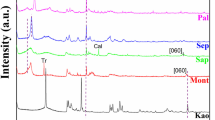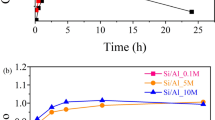Abstract
The electrochemical properties of kaolinite before and after modification with chlorodimethyl-octadecylsilane have been studied by electrophoretic mobility, surface charge titration, and extrapolated yield stress measurements as a function of pH and ionic strength. A heteropolar model of kaolinite, which views the particles as having a pH-independent permanent negative charge on the basal planes and a pH-dependent charge on the edges, has been used to model the data. The zeta potential and surface charge titration experimental data have been used simultaneously to calculate acid and ion complexation equilibrium constants using a surface complex model of the oxide-solution interface. The experimental data were modeled following subtraction of the basal plane constant negative charge, describing only the edge electrical double layer properties. Extrapolated yield stress measurements along with the electrochemical data were used to determine the edge isoelectric points for both the unmodified and modified kaolinite and were found to occur at pH values of 5.25 and 6.75, respectively. Acidity and ion complexation constants were calculated for both sets of data before and after surface modification. The acidity constants, pKa1 = 5.0 and pKa2 = 6.0, calculated for unmodified kaolinite, correlate closely with acidity constants determined by oxide studies for acidic sites on alumina and silica, respectively, and were, therefore, assigned to pH-dependent specific chemical surface hydroxyl groups on the edges of kaolinite. The parameters calculated for the modified kaolinite indicate that the silane has reacted with these pH-dependent hydroxyl groups causing both a change in their acidity and a concomitant decrease in their ionization capacity. Infrared data show that the long chain hydrocarbon silane is held by strong bonding to the kaolinite surface as it remains attached after washing with cyclohexane, heating, and dispersion in an aqueous environment.
Similar content being viewed by others
References
Bolland, M. D. A., Posner, A. M., and Quirk, J. P. (1980) pH-Independent and pH-dependent surface charges on kaolinite: Clays & Clay Minerals 28, 412–418.
Buchanan, A. S. and Oppenheim, R. C. (1968) The surface chemistry of kaolinite: Aust. J Chem. 21, 2367–2371.
de Bruyn, P. L. and Agar, G. E. (1962) Surface chemistry of notation: in Froth Flotation, D. W. Fuerstenau, ed., 50th Anniversary Volume, AIME, New York, 91–134.
de Keizer, A. (1990) Adsorption of paraquat ions on clay minerals. Electrophoresis of clay particles. Progr. Colloid Polym. Sci. 83, 118–126.
Diz, H. M. M. and Rand, B. (1989) The variable nature of the isoelectric point of the edge surface of kaolinite: Br. Ceram. Trans. J. 88, 162–166.
Greenland, D. J. and Mott, C. J. B. (1978) Surfaces of soil particles: in The Chemistry of Soil Constituents, D. J. Greenland and M. B. H. Hayes, eds., John Wiley & Sons, New York, 330–333.
Hair, M. L. (1986) Silica surfaces: in Silanes, Surfaces and Interfaces, D. E. Leyden, ed., Gordon and Breach Science Publishers, New York, 25–41.
Hiemstra, T., de Witt, J. C. M., and van Riemsdijk, W. H. (1989) Multisite proton adsorption modeling at the solid/solution interface of (hydr)oxides: A new approach: J. Colloid Interface Sci. 133, 105–117.
Hunter, R. J. (1981) Zeta Potential in Colloid Science: Academic Press, London, 298 pp.
Hunter, R.J. (1987) Foundations of Colloid Science. Vol. I: Oxford University Press, New York, 316–394, p. 557.
Hurlbut, C. S. Jr. (1971) Dana’s Manual of Mineralogy, 18th ed.: John Wiley & Sons, New York, 426 pp.
Israelachvili, J. (1992) Intermolecular and Surface Forces, 2nd ed.: Academic Press, London, 128–133.
James, R. O. and Parks, G. A. (1982) Characterization of aqueous colloids by their electrical double-layer and intrinsic surface chemical properties: in Surface and Colloid Science, Vol. 12, E. Matijević, ed., Plenum, New York, 119–216.
Jepson, W. B. (1984) Kaolins: Their properties and uses: Phil. Trans. R. Soc. Lond. A 311, 411–432.
Kitchener, J. A. (1992) Minerals and surfaces: in Developments in Mineral Processing, Vol. 12: Colloid Chemistry in Mineral Processing, J. S. Laskowski and J. Ralston, eds., Elsevier Science Publishers B.V., Amsterdam, p. 30.
Koopal, L. K., van Riemsdijk, W. H. and Roffey, M. G. (1987) Surface ionization and complexation models: A comparison of methods for determining model parameters: J. Colloid Interface Sci. 118, 117–136.
Kramer, J. R., Collins, P., and Brassard, P. (1991) Characterization of multiple functional groups on kaolinite: Mar. chem. 36, 1–8.
Messerschmidt, R. G. (1985) Complete elimination of specular reflectance in infrared diffuse reflectance measurements: Appl. Spectr. 39, 737–794.
Morris, H. D., Shelton, B., and Ellis, P.D. (1990) 27Al NMR spectroscopy of iron-bearing montmorillonite clavs: J. Phys. Chem. 94, 3121–3129.
Nguyen, T. T., Janik, L. J., and Raupach, M. (1991) Diffuse reflectance infrared fourier transform (DRIFT) spectroscopy in soil studies: Aust. J. Soil Res. 29, 49–67.
Ohshima, H., Healy, T. W., and White, L. R. (1983) Approximate analytic expressions for the electrophoretic mobility of spherical colloidal particles and the conductivity of their dilute suspensions: J. Chem. Soc, Faraday Trans. 2 79, 1613–1628.
Pleuddemann, E. P. (1982) Silane Coupling Agents: Plenum Press, New York, p. 20.
Pulfer, K., Schindler, P. W., Westall, J. C., and Grauer, R. (1984) Kinetics and mechanism of dissolution of bayerite (γ-Al(OH)3) in HNO3-HF solutions at 298.2 °K: J. Colloid Interface Sci. 101, 554–564.
Rand, B. and Melton, I. E. (1977) Particle interactions in kaolinite: J. Colloid Interface Sci. 60, 308–329.
Scales, P. J., Grieser, F., and Healy, T. W. (1990) Electrokinetics of the muscovite mica-aqueous solution interface: Langmuir 6, 582–589.
Schindler, P. W. and Stumm, W. (1987) The surface chemistry of oxides, hydroxides, and oxide minerals: in Aquatic Surface Chemistry, W. Stumm, ed., John Wiley & Sons, New York, p. 97.
Schofield, R. K. and Samson, H. R. (1954) Flocculation of kaolinite due to the attraction of oppositely charged crystal faces: Discuss. Faraday Soc. 18, 135–144.
Socrates, G. (1980) Infrared Characteristic Group Frequencies: John Wiley & Sons, New York, p. 27.
Stumm, W., Huang, C. P., and Jenkins, S.R. (1970) Specific chemical interaction affecting the stability of dispersed systems: Croat. Chem. Acta 42, 223–245.
Tadros, Th. F. (1989) Rheology of concentrated stable and flocculated suspensions: in Flocculation and Dewatering Proc. of the Engineering Foundation Conf, Palm Coast, Florida, B. M. Moudgil and B. J. Scheiner, eds., Engineering Foundation, New York, 43–87.
van Olphen, H. (1977) An Introduction to Clay Colloid Chemistry, 2nd ed.: John Wiley & Sons, New York, 92–110.
Westall, J. and Hohl, H. (1980) A comparison of electrostatic models of the oxide/solution interface: Adv. Colloid Interface Sci. 12, 265–294.
Wierer, K. A. and Dobias, B. (1988) Exchange enthalpies of H+ and OH− adsorption on minerals with different characters of potential-determining ions: J. Colloid Interface Sci. 122, 171–177.
Williams, D. J. A. and Williams, K. P. (1978) Electrophoresis and zeta potential of kaolinite: J. Colloid Interface Sci. 65, 79–87.
Wood, R. (1990) The electrical double layer properties of oxides: Masters thesis, The South Australian Institute of Technology, 40–50.
Wood, R., Fornasiero, D., and Ralston, J. (1990) Electrochemistry of the boehmite-water interface: Colloids Surf. 51, 389–403.
Author information
Authors and Affiliations
Rights and permissions
About this article
Cite this article
Braggs, B., Fornasiero, D., Ralston, J. et al. The Effect of Surface Modification by an Organosilane on the Electrochemical Properties of Kaolinite. Clays Clay Miner. 42, 123–136 (1994). https://doi.org/10.1346/CCMN.1994.0420203
Received:
Accepted:
Published:
Issue Date:
DOI: https://doi.org/10.1346/CCMN.1994.0420203




